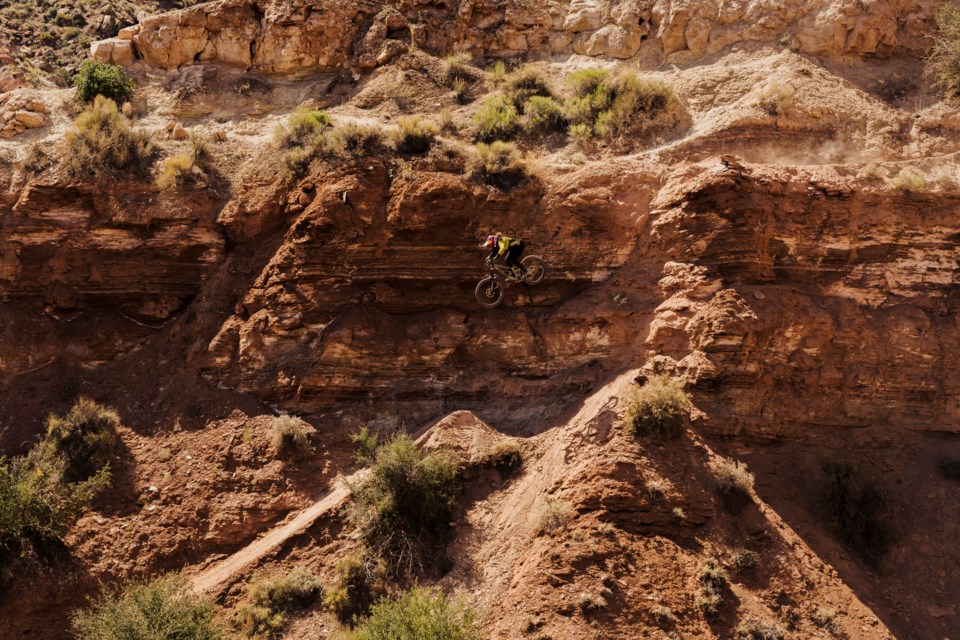I’ve had mixed feelings about Red Bull Rampage for a few years now. There have been standout moments in the Utah desert that seemed to set the stage for the future of the sport, like in 2013 when Cam Zink landed the biggest stepdown backflip to date of 23.7 metres (78 feet). Another mind-blowing moment was in 2015, when New Zealand freerider Kelly McGarry landed a backflip over a 22-metre (72-foot) canyon gap and captured the whole thing on his helmet-mounted GoPro.
There have been dozens of other genre-defining moments at Rampage, from Canadian freeride icon Wade Simmons winning the inaugural event in 2001 (on a bike that would barely survive a week in the Whistler Bike Park these days) to slopestyle veterans Brandon Semenuk and Brett Rheeder winning two Rampage titles each in the last four years. And I couldn’t talk about this event without giving a shoutout to Nelson, B.C.’s Kurt Sorge, who’s earned three Rampage titles since 2012.
As much as there’s been to celebrate with Rampage, there have also been the years when I questioned the motivations for it. In 2013, writer Mitchell Scott published a very different and visceral opinion in an article titled “RAMPAGE: CATCH-22.” It described not just the perilous risks riders were taking, but how those risks needed to be amplified 10-fold in order to achieve a podium finish.
Riders aren’t forced to compete at Rampage, and never have been. But if you want to make it to the big league sponsorships of the sport, you have to put your neck on the line at Rampage. The media reach of the event has helped the sport break into the mainstream while propelling its winners’ careers into the stratosphere, so… worth it?
The point of all this preamble is that everything I’ve mentioned so far about Red Bull Rampage and the athletes that compete has been 100-per-cent male-dominated. And if you’re not aware of the level of women’s freeriding these days, it’s not all your fault. Unlike World Cup racing, media coverage of women’s freeride events has been lacklustre at best.
A non-competitive event called Formation kicked off in 2019 with the aim of changing that. It even had Red Bull backing it. Formation was a group of freeride women who gathered at one of the older Rampage venues, dug their lines, shaped their jumps, and sent it. The goal was to get these highly skilled female riders more comfortable in the exposed and hazardous terrain that one finds in Virgin, Utah, without the added pressure of the world watching.
At the 2022 event, Casey Brown rode Rheeder’s 2015 Rampage line and made it look very smooth. The intent of Formation—to serve as an incubator for female freeride talent—was clearly working.
Earlier this year, Red Bull announced that Formation 2023 was cancelled. Disappointing, yes. But all eyes were glued on the soon-to-be-announced Rampage invite list, hoping this would be the year the energy-drink giant would invite a few women to compete alongside the men, to give the rising stars of female freeride some well-deserved Rampage airtime.
Unfortunately, it was not the year. Familiar male faces, some new blood, and some old fossils (in freeride terms) made up the invite list. A few high-profile athletes declined to compete. But no women.
In a recent interview with the Pinkbike Podcast, Vaea Verbeeck, one of the leading female freeriders in the world, revealed Red Bull wants to bring back Formation and develop it towards a proper—albeit separate—competition. After quite a bit of public backlash across the mountain bike industry last week, Red Bull released this statement: “Red Bull Rampage is the most difficult freeride mountain bike competition in the world. For this reason, a selection panel invites the best 18 riders globally to compete. We are exploring with industry experts how we might develop a women’s category at Red Bull Rampage.”
Rampage is a difficult live event to run. Wind wreaks havoc on the athletes and can make an already hazardous venue life or death. Organizers will often reduce the competition from two runs to one on account of the wind windows, making every minute critical for viewership.
Would adding a handful of women to the roster reduce the visual appeal of the event? I don’t think so. I would rather see Brown or Verbeeck complete the run of their lives and make history than watch another mediocre men’s run from athletes who probably should have retired after their last near-death crash.
Since announcing the male-only invite list, Red Bull has borne the social media brunt of its decision to keep Rampage status quo in 2023. The female riders lobbying for inclusion have made it clear they are huge fans of Rampage, and that they’re not asking to take the spots of male competitors. They’re not looking for token appearances or a watered-down, female-only event. They simply want to show the world that female freeriders are ready to put their own necks on the line for Rampage glory.
It might take more money and it might take some convincing of white guys sitting around a boardroom table, but the people have spoken. The ladies of Rampage deserve a seat at the table.
Vince Shuley is looking forward to seeing the 2024 Rampage start-list. For questions, comments or suggestions for The Outsider, email [email protected] or Instagram @whis_vince.




